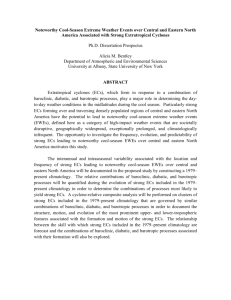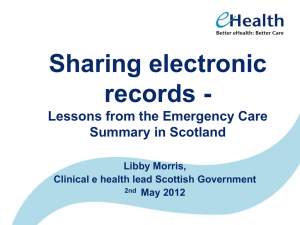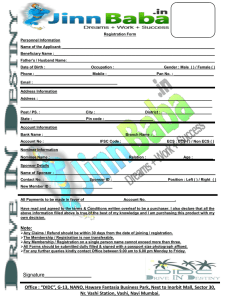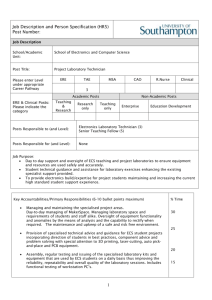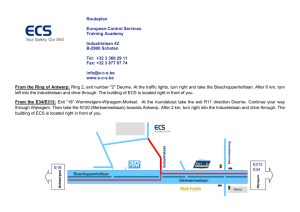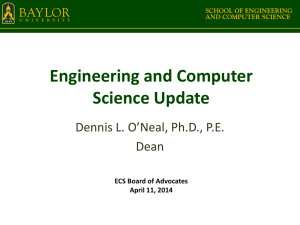Child rights and health
advertisement
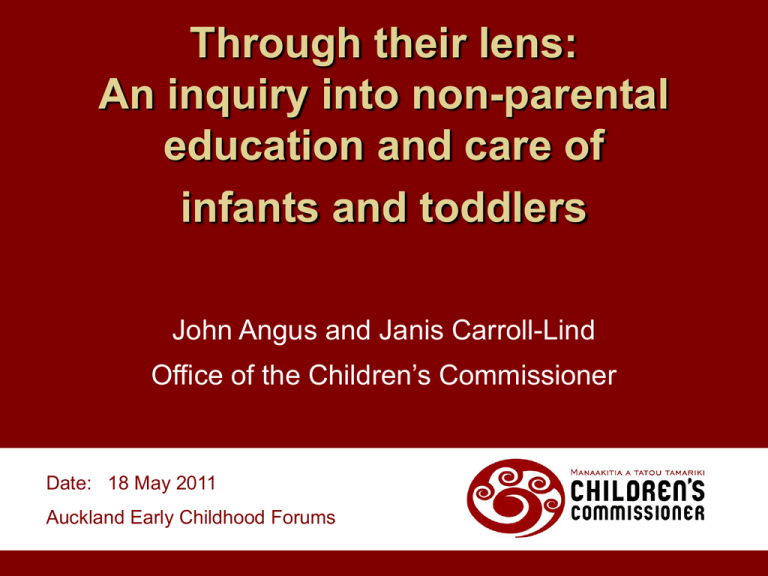
Through their lens: An inquiry into non-parental education and care of infants and toddlers John Angus and Janis Carroll-Lind Office of the Children’s Commissioner Date: 18 May 2011 Auckland Early Childhood Forums Specific objectives • Current patterns in ECS usage • Impacts, benefits, risks & mitigations for under-2s • Policy and regulatory impacts • Parental decision-making • Key policy and practice issues • Recommendations to government and sector Theoretical perspectives • Child’s perspective (infant & toddler viewpoint) • Sociocultural theory (infant-toddler agency) • UNCROC (Articles 3 and 18) • Dual socialisation model • Child’s questions • 4 “A” right to education framework References Sommer, Pramling Samuelsson, & Hundeide. (2010). Smith (2001); Smith & Taylor (2000); Wenger (1998). United Nations (1989). Sommer (2011). Podmore, May, & Carr (2001). Human Rights Commission (2010). . UNCROC Article 3 In all actions concerning children, the best interests of the child should be a primary consideration. References United Nations (1989). The United Nations Convention on the Rights of the Child. Author: Geneva. UNCROC Article 18 Parents have joint primary responsibility for raising the child, and the State shall support them in this. The State shall provide appropriate assistance to parents in child raising, such as ensuring the development of institutions, facilities and services for the care of children. Reference United Nations (1989). The United Nations Convention on the Rights of the Child. Author: Geneva. Dual Socialisation Butterfly Family wing: C: Child Ps: Parent(s) S: Sibling(s) Child care wing: C: Child ST: Staff CG: Child Group References Sommer, D. (2011). A childhood psychology. Young children in changing Times. Reflections on a paradigm shift. Basingstoke: Palgrave-MacMillan. The child’s questions Strands of Te Whariki Learning and development questions The “child’s questions” Belonging Do you appreciate and understand my interests and abilities and those of my family? Do you know me? Well-being Do you meet my daily needs with care and sensitive consideration? Can I trust you? Exploration Do you engage my mind, offer challenges, and extend my world? Do you let me fly? Communication Do you invite me to communicate and respond to my own particular efforts? Do you hear me? Contribution Do you encourage and facilitate my endeavours to be part of the wider group? Is this place fair for us? References Podmore, V., May, H., & Carr, M. (2001). “The child’s questions”. Programme evaluation with Te Whariki using “Teaching Stories”. Wellington: NZCER. Policy and regulatory settings • Complex with incoherence across policies and regulatory regimes • Diverse providers • Complicated interacting mix of licensing, regulation, monitoring and funding incentives • Parental leave policy is separate from education and care policy • Public health issues are separate from issues of educational development Funding regime • Subsidies into mid-ranges of family incomes • Limited and inflexible paid parental leave provisions • ECEC subsidies are: paid to ECS, not means tested, and meet much of the actual costs Policy about provision • Non compulsory and government strategy to increase participation of 3 and 4-year-olds • Provided by NGOs • Vary in ownership, governance & commercial purpose and government agnostic to those variables • User pays but heavy government subsidy • Extensive regulation but relatively light monitoring • Traditional focus on education of 3 and 4-year-olds Patterns of education and care for infants and toddlers • Fastest growth area • Dominated by home-based and ECEC centres • Increasingly younger with parents who can afford fees • Attendance is longer and for more days a week • Participation, supply and demand issues • Mixed provisions Acceptability, accessibility, availability and adaptability Challenges • Culturally appropriate ECS • Neighbourhood proximity • Access to information • Limited availability (wait lists, hours, age, location, affordability) • Inflexible ECS (part time, hours, days • Adapting to meet diverse needs of under-2s Impacts, benefits and risks • Assessment challenging, multiple variables • Little research on direct benefits to under-2s • Unclear evidence for under-2s except quality is key • Debate around degree of risk • Disrupted attachment and exposure to illness Mitigations • Shorter rather than longer durations • Quality ECS attend to attachment and health risks Parental choice and decision-making • Choice constrained by factors other than their preference • Comfortable with choices but did not always lead to high quality education and care Auckland issues • Wait lists in CBD (traffic) • Pasifika families least catered for • Local children missing out in quality ECS (drive ins) • Finding the “right” service • Administrative confusion for some families • Staffing and affordability challenges Quality education and care for under-2s • High adult to child ratios (1:3 for under-2s) • Small group sizes (6-9) • Staff education, qualifications and skills • Positive, sensitive and responsive relationships • Superior physical environments • Significant parental involvement • Attention to health and safety • Effective pedagogy & socially, culturally, developmentally appropriate curriculum Key practice implications • Quality education and care • Practices that enhance responsive relationships • Education and professional learning in under-2s • Better management of health-related interests of infants and toddlers Key policy implications • Policies that support parental care in the first 12 months • Policy settings that allow for flexible use of ECS for under-2s • Policy and regulatory settings that support quality provisions • Policies that support provisions of ECS by a knowledgeable and skilled workforce Conclusions on education and care of infants and toddlers • Quality ECS not inimical to the interests of under-2s • Contributes, in partnership with parents and whanau, to a child’s learning and development • Obligation (UNCROC) to consider children’s best interests in policies, regulations and practices Recommendations • Policies that support parental care in the first 12 months • Policies, regulatory settings and funding structures that allow for flexible use of ECS by under-2s • Policies and regulatory settings that support quality service provision for under-2s • Policies that support the provision of ECS to under-2s by a knowledgeable and skilled workforce Recommendations cont. • Practices that enhance responsive education and care • Education and professional learning • Improved management of health interests of infants and toddlers in ECS • Information to support parents’ decision-making Support for parental care in first 12 months • Review paid parental leave and ECS funding • Provide advice on increasing quantum and flexibility of support for parental care • Provide advice on merits of having ECS funding attached to the child rather than tied to types of provision and paid to providers Policies, regulatory settings and funding structures that allow for flexible use of ECS by under-2s • Review settings for impact on flexible provision of hours/days of attendance • Provide advice on changes to improve access to part-time and flexible education and care Policies and regulatory settings that support quality service provision • Limit group size to no more than 9 under-2s • Reduce minimum ratio from 1:5 to 1:3 in centres and from 1:4 to 1:3 for home-based educators with 2 children under-2 • Increase minimum space from 2.5 m2 to 3 m2 • Support ECS to include quiet spaces in design and layout and provision of acoustic absorption materials to reduce noise levels Policies that support the provision of a knowledgeable and skilled workforce • Report extent to which services to under-2s are provided by qualified and registered teachers, and occurring trends • Advise extent to which changes are a consequence of the recent regulatory and funding changes and on any remedial changes that are necessary • Amend regulations in mixed age settings to apply the minimum of 50% of qualified, knowledgeable, and skilled staff to service provision in the under-2 area Practices that enhance responsive education and care • Note quality issues confirm ERO’s 2010 findings • Note relicensing process will not address concerns for many children over the next 3 years • Consider how to improve practice quality more quickly Education and professional learning • Note role of education and professional learning to quality • Encourage focus on professional development relevant to infants and toddlers • Reconsider decision to cease practitioner research initiatives • Consider amending regs to ensure under-2 staff have obtained or are obtaining professional development on working with under-2s • Review home-based regulations to increase levels of support for educators’ skills and knowledge Education and professional learning initial teacher education • Encourage providers to review ITE programmes to ensure adequate content specific to under-2s • Support providers to offer postgraduate papers and qualifications for infant-toddler specialisation Improved management of health interests of under-2s in ECS • More health/education overlap in policy development, regulation and operational planning for ECS • Advise on merits of registered health professionals with appropriate qualifications counting as additional qualified staff • Increased engagement of primary health professionals • Review adequacy of health monitoring standards Information to support parents’ decision-making • Review MoE website to enhance parents’ information • Improve parents’ access to information through links to other websites and in community settings Ahakoa he iti, he pounamu All be it small, it is a treasure
